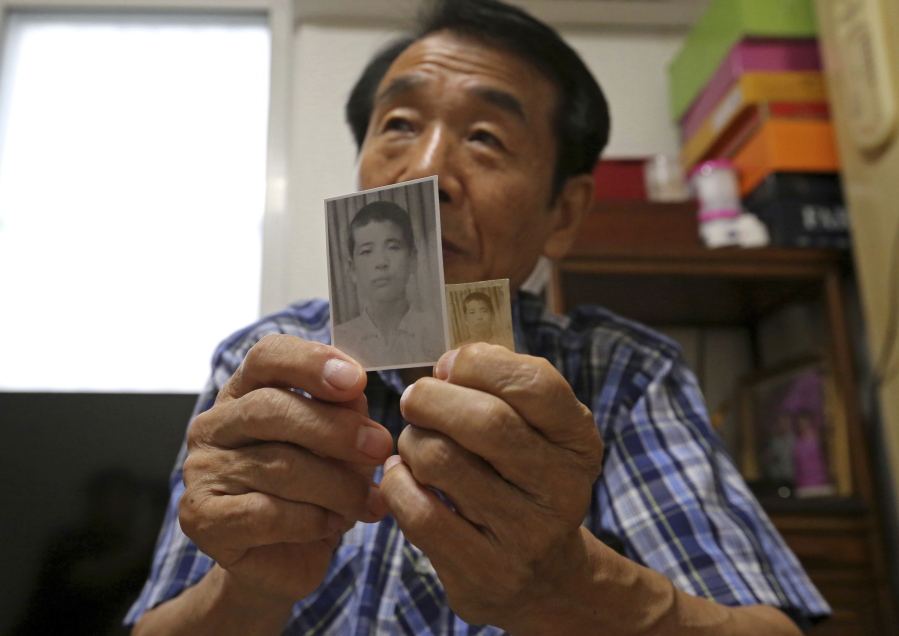SEOUL, South Korea — Lee Soo-nam was 8 the last time he saw his older brother. Sixty-eight years ago this month the boy watched, bewildered, as his 18-year-old brother left their home in Seoul to escape invading North Korean soldiers who were conscripting young men just weeks after invading South Korea to start the Korean War.
An hour later, his brother, Ri Jong Song, was snatched up by North Korean soldiers near a bridge across Seoul’s Han River. Lee always assumed Ri died during the three-year war that killed and injured millions before a cease-fire in 1953, but his mother prayed daily for her lost son’s return, giving up only a few years before her death in 1975.
But Ri survived the war, living in North Korea. The brothers, now 76 and 86, will be among hundreds of Koreans who will participate, starting Monday, in a week of temporary reunions of divided families. Many have had no contact with each other since the war cemented the division of the Korean Peninsula into the North and South.
The elderly relatives gathering at North Korea’s scenic Diamond Mountain resort know that, given the fickle nature of ties between the rival Koreas, this could be the last time they see each other before they die.
“I’m nervous. I’m still unsure whether this is a dream or reality. I just want to thank him for staying alive all these years,” Lee said in an interview in his home in Seoul, not far from where he last saw his brother.
Since the end of the war, both Koreas have banned ordinary citizens from visiting relatives on the other side of the border or contacting them without permission. Nearly 20,000 people have participated in 20 rounds of face-to-face reunions since 2000. No one has had a second chance to see their relatives.
This week’s reunions come after a three-year hiatus during which North Korea tested three nuclear weapons and multiple missiles that demonstrated the potential of striking the continental United States.
At past meetings, elderly relatives — some relying on wheelchairs or walking sticks — have wept, hugged and caressed each other in a rush of emotions. According to Seoul’s Unification Ministry, which handles inter-Korean affairs, more than 500 separated South Koreans and their family members will cross the border for two separate rounds of reunions between Aug. 20 and 26.
At Diamond Mountain, Lee expects to meet Ri and his 79-year-old North Korean wife and 50-year-old son. Lee will bring more than a dozen family photos, including a black-and-white picture of Ri in a buzz-cut when he was 16 or 17.
“That’s how I remember him,” Lee said. “I lost a brother and my parents lost a child, but my brother lost his parents, siblings, friends and an entire hometown, and he probably spent his whole life longing for all of those things. It’s heartbreaking to think about.”
The difference in the siblings’ family names is a product of the Korean Peninsula’s division — each country uses different English transliteration rules, so Lee in the South is spelled Ri in the North.
Many of the South Korean participants in the reunions will be war refugees who were born in North Korea.
Kim Kwang-ho, 79, was among some 14,000 refugees who were ferried to South Korea by the American freighter SS Meredith Victory in December 1950 in one of the world’s largest humanitarian operations. Also on the ship were the parents of current South Korean President Moon Jae-in, who described the evacuation as a “voyage of freedom and human rights” in a speech in Washington last year.
At the reunions, Kim expects to meet his 78-year-old brother, Kim Kwang Il, and his sister-in-law. Kim has vivid memories of what he described as a beautiful hometown in northern North Korea, where he plowed rice and corn fields with cattle, picked peaches and apricots from trees and spent hours swimming in brooks.
He gets emotional when talking about the mother he left behind, who used to cry over the death of his brother during the war.
“I have clear memories of events that happened,” Kim said. “But somehow I can’t remember the faces of my mother and brother.”
Behind the raw emotions, the meetings are tightly coordinated events where participants are closely watched by North Korean officials and dozens of South Korean journalists.
As in previous reunions, South Korea’s Red Cross, which organizes the events with its North Korean counterpart, has issued a guidebook telling South Koreans what to do and what not to do.



